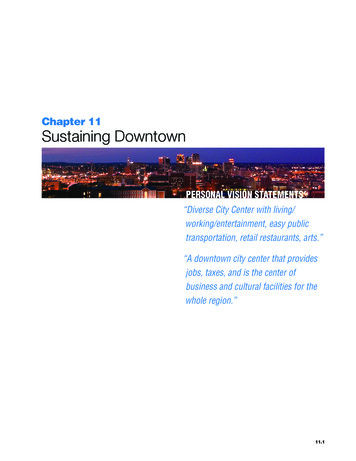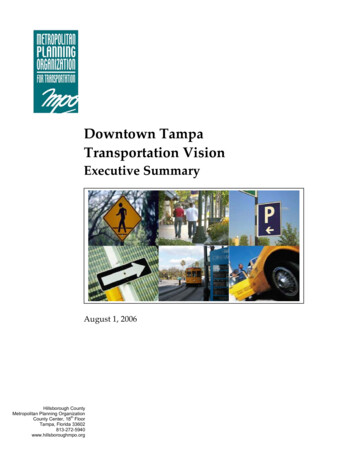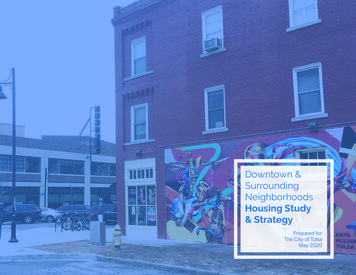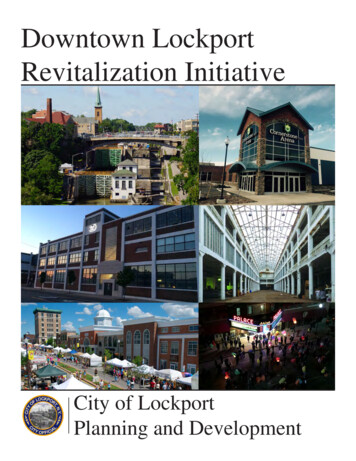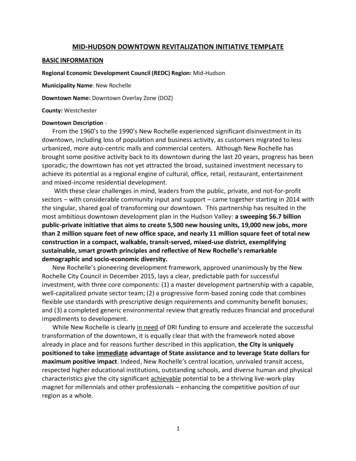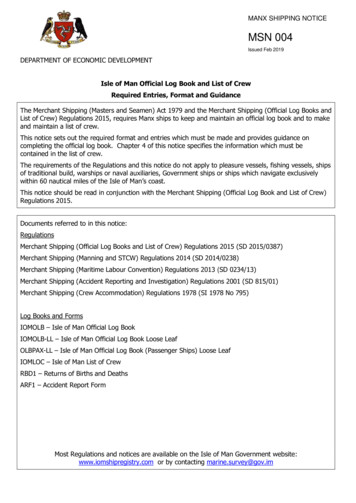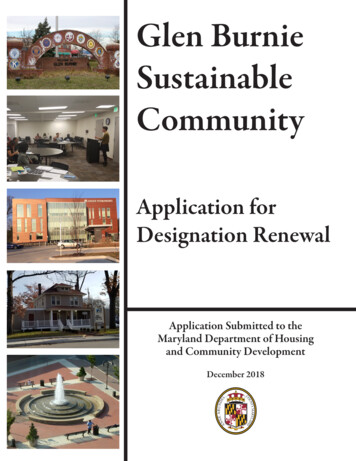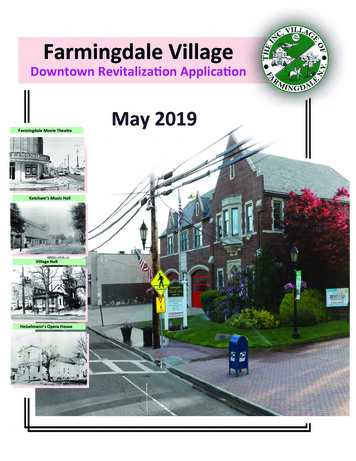
Transcription
Downtown RevitalizationInitiativeVillage of Farmingdale ApplicationMay 2019Board of TrusteesHonorable Ralph Ekstrand, MayorHonorable William A. Barrett, Deputy MayorHonorable Cheryl L. Parisi, TrusteeHonorable Walter Priestley, TrusteeHonorable Anthony J. Addeo, TrusteeBrian Harty, Village AdministraatorClaudio DeBellis, Village AttorneyPrepared by:Cheryl Parisi, TrusteePatricia ChristiansenVicki Gruber
Table of ContentsBasic Information . Page 1Preamble . Page 1Vision for Downtown . . Page 4Justification . . Page 5Boundaries of Proposed DRI. Page 6Past Investment, Future Investment Potential. Page 7Recent or Impending Job Growth . . Page 16Attractiveness of Physical Environment . . Page 17Quality of Life Policies . Page 19Public Support. Page 22Transformative Opportunities. Page 23Administrative Capacity . . Page 23Other . Page 23
VILLAGE OF FARMINGDALE2019 NYS – DRI ApplicationBASIC INFORMATION:*REDC Region: Long Island*Municipality Name: Incorporated Village of Farmingdale*Downtown Name: Farmingdale Center for the Arts*County Name: Nassau County*Applicant Contact, Name and Title: Cheryl L. Parisi, Village TrusteeBrian Harty, Village Administrator*Applicant Contact Email and Secondary Email Address: e sits near the eastern end of what was the Hempstead Plains: the vast, treeless prairie that covered central Nassau County. Thomas Powell purchased a 15-square mile tract of landfrom three Native American tribes (Maraspeague/Massapequa, Matinecock and Secatogue), inOctober 1695 for 140 English pounds sterling. This is known as the Bethpage Purchase. The Powell family home still stands today on Merritts Road. After Powell’s death, his property was dividedamong his children and their heirs and evolved into several farming communities. The area wasknown as “Hardscrabble.”In 1838, anticipating construction of the Long Island Rail Road, Ambrose George acquired a largetract of land in preparation for the new railroad, opened a general store, subdivided his land, laidout streets and renamed the inelegant “Hardscrabble” to a more bucolic “Farmingdale.”The Farmingdale LIRR station became a key stop for the LIRR where steam locomotives could refuel and get water, as well as for passengers and cargo shipping to New York City. Stage coachescarried passengers further east and the Cross Island Trolley ran from Huntington through Farmingdale to Great South Bay in Amityville.Industry came to Farmingdale in 1865 with the founding of brick factories. Other businesses followed, including a lumberyard and pickle factories.Farmingdale and the surrounding area became home to three aviation plants, Bethpage StatePark, Farmingdale State College, Farmingdale Public Library, and School District 22 of the Town ofOyster Bay and, by the late 1800’s, five churches were part of its landscape.From its beginnings, Farmingdale Village was a popular downtown destination with several hotels, grocery and feed stores, and theaters offering vaudeville entertainment programs.1
Village Timeline2
Noon’s Hotel - Looking South on Main Street from SouthFront Street ca. 1860’sKetcham’s Music Hall on Main Street ca. 1895Looking South on Main Street ca. 19503
Looking South on Main Street ca. 2018VISION FOR DOWNTOWNOur vision for the revitalization of Farmingdale Village’s downtown is to build a Cultural ArtsCenter with surrounding greenspace, walkways and parking. The Cultural Arts Center would hostlive performing arts and cultural events, as well as exhibits and classes. The greenspace andwalkways would be curated to honor our agricultural and aviation history, and the parking spaceswould complement our beautification efforts and our transit-oriented infrastructure, add shuttlebuses, and alleviate concerns of residents.In 2010, the Village accepted a master plan which, among other improvements, recommendeda cultural and performing arts venue. Although Farmingdale has implemented many of the recommendations of this plan, it has not yet created a Cultural Arts Center. In recent years, it hasbecome apparent that this is a key element missing from our downtown, and one that has beenrequested by hundreds of community members, and supported by local organizations and potential partners.4
JUSTIFICATIONThe downtown area has undergone tremendous improvement over the last few years, but aCultural Arts Center has not yet been achieved. Farmingdale’s downtown area is characterizedby a vibrant Main Street with revitalized restaurants, improved signage, affordable housing, arenovated LIRR station, improved parking lots, and extensive beautification efforts, including itsVillage Green, which hosts outdoor events but lacks the capacity to host large-scale indoor programs. The Village Green has hosted outdoor concerts, art exhibits and cultural performances,which have enjoyed tremendous success and attracted residents and visitors to our downtownarea in fair weather. In applying for the DRI grant, the Village is seeking to capitalize on the success of its outdoor events by constructing a facility that can be used year-round, in all weather.Our downtown is ready for a Cultural Arts Center, and the Village Board has identified one ortwo properties that would be suitable for redevelopment for this purpose. Almost 300 modernapartments were recently built within walking distance of the downtown area. Although ourdowntown restaurants are major draws both within and outside the community, our residentshave expressed the desire for more than just dining and drinking establishments. Local homeowners and renters alike would welcome a place to enjoy plays, concerts, dance performances,lectures and cultural events, as well as art and historical exhibits and courses in art and culture.Building the Cultural Arts Center would serve as a major catalyst by attracting local residentsand drawing visitors from surrounding areas.The Village of Farmingdale straddles both Nassau and Suffolk Counties, and is located near theRoute 110 Corridor, minutes from the Long Island Expressway and the Southern and NorthernState Parkways. Its newly renovated LIRR station is within walking distance of the downtownarea targeted for the DRI. The downtown area is also adjacent to Hempstead Turnpike/ConklinStreet, and is served by buses that run east and west throughout Long Island. Buses also runnorth and south along Route 110. Our downtown area is easily accessible by road, rail, bus andlocal pedestrians. We are also near biking trails, and propose to install secure bike racks as partof the Farmingdale Center for the Arts project.The Cultural Arts Center would serve as a catalyst by creating jobs for people involved in theconstruction, operation and maintenance of the facility, by performing arts groups who wouldutilize the space, by personnel involved in marketing and promoting events, by artists and others who would be able to exhibit and sell their creations, and by local merchants whose establishments would benefit from the additional foot traffic through the downtown area.5
DOWNTOWN IDENTIFICATION1.Boundaries of the proposed DRI area:The downtown area is located in the central portion of the Village, running along Main Streetfrom Fulton Street (NYS Route 109) in the south to Melville Road in the north. The area continueseast along Sullivan Road to the Nassau-Suffolk County line and to Columbia Street in the west.The subject area of the application is within the red dotted line.6
2.Past Investment, future investment potential:In 2003, the Village Mayor formed a Smart Growth Committee which approved senior citizens’complexes but did not correct the economic difficulties that the Village was facing. The area adjacent to the LIRR station was deteriorating when a vacant warehouse became the site of illegalactivities.In 2006, the Village embarked on a major study of its downtown. This began with a VisioningConference, consisting of three separate sessions, which drew attendance of over 300 peoplewho expressed their concerns and desires for the future of the Village’s downtown. This effortwas prompted in part by the fact that the downtown had a startling 26 vacant storefronts and inadequate housing options, i.e., very limited housing in close proximity to the train station. Therewere several blighted areas within the Village, and residents expressed a vital need to keep youngpeople in our Village and to provide the means to live, work, and “play” in the community.Vacant stores on Main Street in 20067
The “Visioning meetings” were enthusiastically embraced by residents. This encouraged the Village Board to establish a Downtown Revitalization Committee consisting of government officials,stakeholders, merchants and residents.In 2008, the Village filed an application and was awarded a Brownfield Opportunity Grant to improve the blighted area at the LIRR train station, as well as its downtown Main Street. The Committee began an aggressive campaign by interviewing and selecting land use consultants to assistit in its endeavor to revitalize the downtown. The four-year study included architectural review,density studies, economic factors, and environmental issues.Existing Land Use in the Village of Farmingdale8
The final results of this study were the Downtown Farmingdale 2035 Master Plan. This Plan included recommendations for a downtown concept, land use and zoning, design plans, economicdevelopment strategies, parking, transportation, infrastructure improvements and a culturalarts venue. Specifically, the Plan recommended the restoration of a “theater, whether a movieor performing arts theater [which] will bring a much needed cultural attraction to the downtown area.” The Downtown Master Plan, as a guide for smart growth and revitalization for theVillage of Farmingdale, fits into the context of other regional efforts on sustainability and is seenas an important element of these planning and policy initiatives.Sites Subject to Change as identified by the Downtown Master Plan9
The Village invested funds from its tax revenues, as well as 4,649,365 in grant funds receivedfrom federal, state and county agencies, to develop a vibrant Village Green adjacent to its VillageHall, improve the signage on the stores and restaurants on Main Street, renovate the historic LIRRstation, improve parking lots, and make extensive beautification efforts.10
11
Station was built in 1895.The station has been restored to its original look.After much discussion and public input, The Farmingdale School District chose to construct itsnew 30 million Athletic Center on the campus of Howitt Middle School in the heart of the Village. This site was chosen over the Farmingdale High School campus located two miles from thedowntown in South Farmingdale. Their reason for this choice was due to the close proximity toMain Street offering attractive dining facilities to participants and spectators. They also felt thatthe Board of Trustees had made tremendous changes to the downtown and they should followthe Villages lead. They created the eastern gateway into the Village along Conklin Street.Newly built athletic complex at Howitt Middle School with baseball, softball and multi-purpose athletic field forfootball, lacrosse, soccer and field hockey. The southwest corner will be home to an Aquatic Center.12
Aquatic Center to be built at the Howitt Middle School on the Southwest corner. It will house an Olympic size poolfor swim and diving meets as well as a smaller pool for community use.Over the past decade, the Village has done much to improvethe quality of life in its downtownarea, but one key element remainsmissing: a center dedicated to thearts, entertainment and other cultural activities. This element wasidentified in the Village’s MasterPlan and the community has expressed strong support over theensuing years, as recently evidenced by public hearings heldduring 2018.Farmingdale Village has beensteeped in cultural arts for many years. In 1909 Heiselman’s Opera House opened at Rose & Richard Streets and provided live performances for over six years.Farmingdale had two movie theaters, the Unqua and the Strand, which dated back to the silentfilm era. The Unqua stood on the east side of Main Street a few shops north of Conklin Street.It was originally a primitive shed-like structure, but was later remodeled into a traditional movietheater. The Strand, whose structure still stands, was on Main Street near the corner of ProspectStreet. Both survived into the era of “talkies,” which began in 1927.13
The Farmingdale Theater, built adjacent to the Strand at the corner of Main and Prospect Streets,opened in early 1942, only weeks after the bombing of Pearl Harbor. This beautifully appointedtheater suffered a fire in 1950 but was quickly rebuilt. Like many movie theaters across the nation, the Farmingdale Theatre eventually succumbed to cable TV, rental movies on VCR’s, andmulti-screen entertainment complexes. It closed in 1984 and was remodeled into an office building.The Farmingdale Theater on Main Street in Farmingdale (1978).Photo Credit: Newsday Dick Kraus.There are currently several active theater groups in the community who perform at St. KilianChurch, St. Thomas Church and the Farmingdale Public Library. Unfortunately, these facilitieshave limited times available for these theater groups to utilize their facilities. A local Long Island,theater group has expressed strong interest in leasing a portion of the Cultural Arts Center for itsyear round live theater productions.The Village does have the ability to finance a bond but, with the infusion of DRI funds, it couldswiftly develop a currently vacant building adjacent to its Village Hall and Fire House. A CulturalArts Center would be the keystone in the Village’s emergence as a vibrant neighborhood thatcould attract newcomers to settle, find work, raise families and engage in the community. In-14
frastructure like diverse and affordable housing, mass transportation via train and bus, thrivingrestaurants and retail stores, and a growing college campus are already in place. Curated greenspace and exhibition space would improve the quality of the downtown area and renovate andre-energize unsightly or poorly planned areas.CULTURAL ARTS CENTEROverview. The centerpiece of our downtown revitalization efforts will be the construction anddevelopment of a Cultural Arts Center and surrounding greenspace, walkways and parking. Weenvision a Cultural Arts Center with the capacity to seat at least 250 people for cultural and performing arts events, such as plays, concerts, dance performances, films, lectures and other eventsthat enhance our community’s understanding and appreciation of the arts, and the cultural richness and diversity of people both within and outside our own community.Gallery, Classrooms and Concessions. The Cultural Arts Center would also contain gallery andexhibition space for works of art, historical artifacts and exhibits, book signings, and other events,as well as classroom space for education in the arts and culture. This could serve as a communityeducational space for residents and visitors of all ages, including seniors, as there is not currentlya senior center in our community.We also propose to include a small gift shop or concession area where local artists and otherfeatured craftspeople can exhibit and sell their works on a consignment or other basis, which willcontribute monetarily to the economic sustainability of the Cultural Arts Center, as well as ourlocal artists and performers.Parking and Shuttle Buses. We anticipate that the Cultural Arts Center will draw visitors who livewithin walking distance to the downtown area, such as in the hundreds of new apartment unitsthat have been built here in recent years. In order to facilitate maximum commercial success ofthe venue, the Cultural Arts Center should also be able to attract visitors who drive to the venuefrom other areas on Long Island, which will require adequate parking. Therefore, the CulturalArts Center must include enough parking spaces to accommodate its events.Based on prior community input, we estimate that 150 parking spots would be a minimum requirement. If Farmingdale is selected for the DRI grant, we propose to apply a small portion ofthe proceeds to commission an independent parking study to ensure adequate parking for thevenue. Part of our plan is to redevelop blighted and underutilized spaces for parking, and to develop supplementary transportation, such as shuttle buses. The Village recently initiated a “QuickRide” program for summer weekends where people can be driven from the train station to MainStreet. With the help of funds from the Downtown Revitalization Initiative, this program could be15
further expanded to include weekly service to year round events. The program will also facilitatevisitors to the Cultural Arts Center who decide to travel not only by train, via the Long Island RailRoad, but also by buses, which run along Hempstead Turnpike. This program is being sponsoredjointly by the Village and the Village Merchants Association. Our downtown is easily accessiblefrom all areas of Long Island (minutes from the Long Island Expressway, Northern and SouthernState Parkways, Route 110 and Route 109), which will contribute to attendance at the CulturalArts Center.Greenspace and Walkways. A key requirement of the Cultural Arts Center is that it beautifies ourcommunity. The Village of Farmingdale takes great pride in the work of our Beautification Committee, and in the aesthetic charm of the Village, from the architecture of our buildings and storefronts, to detailed flourishes like our clock tower, brickwork, hanging baskets, seasonal plantingsand other graceful features. The design of the Cultural Arts Center, as well as its parking spacesand walkways, must complement and enhance this aesthetic. A major part of ensuring this willbe the installation of greenspace along all adjacent walkways. Farmingdale’s history includes itsinvolvement in agriculture and horticulture, and we intend to incorporate well-designed landscape installations to reflect this heritage.3.Recent or impending job growth:The Village’s new Transit Oriented Developments are comprised of 266 units of housing, including work-force affordable apartments. These new residences have attracted young professionalmen and women, as well as long-term residents who have chosen to downsize their residencesyet stay in the Village. All residents, regardless of their tenure in the Village, are attracted to anactive lifestyle that has been enhanced by the walkability of our downtown. The demographics ofnewer members of the community include young, single people beginning their careers, as wellas newly-married couples, starting their lives together. An arts and entertainment venue wouldadd vibrancy, connectivity and cultural cohesion for residents and visitors alike, increase businessfor existing establishments, increase job opportunities, attract newcomers to the town, and establish a repository to honor the Village’s historical past.The Village is currently close to forming a Business Improvement District for its downtown. TheBID has plans to provide marketing opportunities for its member businesses which will result infurther increasing job opportunities.16
Jefferson Plaza Phase I and Phase II - Transit Oriented Development. The project has 153 apartments - studio,one and two bedrooms with restaurants, professional and retail establishments on the ground floor.4.Attractiveness of physical environment:Located within the downtown area are three pocket parks as well as our very popular VillageGreen, home to weekly “POPS” concerts, comedy nights, Historical Society lectures and festivals,weekly family movie nights, Farmer’s Market and spring and Fall Fairs, annual Art-in-the Park festival, Medieval Times event and Cultural Arts Diversity Day.Additionally, Main Street is closed several times a year during the summer for evening “Music onMain” Festivals.If Main Street was enhanced by a Cultural Arts facility, many of these programs could be offeredyear-round rather than only during the months of June, July and August, when weather permits.17
Village Green, Fire House and Village HallA Cultural Arts Center with a gallery for art and historical artifacts contributed by the Farmingdale-Bethpage Historical Society, as well as rotating exhibits dedicated to Long Island history,could offer programs throughout the year to young children, teenagers, families and seniorcitizens.Farmingdale Village offers a diverse housing market of single family homes, one, two and threebedroom apartments, and subsidized senior citizen residences within walking distance to ourdowntown area. All residents have the convenience of walking to Main Street to enjoy the attractions being offered. A Cultural Arts Center will only add to these cultural experiences.Farmingdale offers many attractions for sports and athletics. It is part of the Greenbelt Trail, afeature for hikers, runners and bikers alike. It is home to the Bethpage Golf Club, and the site ofthe famous “Bethpage Black Course,” which offers both national (2019 PGA), (2021 Northwell[formerly Barclay’s]) and international (2024 Ryder Cup) tournaments. But, it is lacking a Cultural Arts Center.18
5.Quality of Life policies:The Downtown Farmingdale 2035 Master Plan provided a basis for increasing the livability andquality of life in our Village. New, more modern, zoning codes have been adopted. Additionalparking has been added throughout the Village by reconfiguring existing parking lots, improvingvacant land to accommodate more cars, adding traffic calming measures, and increasing transitoriented development. All new construction of transit development projects provides for adequate parking for all residents, thereby eliminating use of public parking facilities.A panoramic view of Parking Field 2. The parking field has been completely reworked to provide additional parking, landscaping, fencing and lighting in order to create a gateway to the downtown area. The Village has similarlyenhanced and reworked its other parking fields to create attractive gateways into the downtown area.19
The monument sign and landscaping found at Field 2 will be seen in all of the Village’s parking fields.The Village has invested heavily in its infrastructure, with an emphasis on energy conservation.It has installed natural gas lines for emergency generators at our water supply wells. It has improved street lighting with LED bulbs, providing greater light at lesser cost. It recently purchasedmany new utility trucks and related equipment, and is in the process of constructing a new Department of Public Works building to house them. This new building will be powered by solarenergy.The Village is also planning to build a new water tower in the next two years, to replace a 100year-old structure. It also installed high-pressure water zones in the northern area of the Village,in order to correct a problem for homeowners in that area that had existed for over fifty years.The Village also has a sidewalk replacement program available to all residents.20
During the past year, the Village created a third pocket park by purchasing a deteriorated building on Main Street, removing the structure, and installing lighting, with park benches and plantsto be installed for all to enjoy.Newly purchased property to create a passive park leading to Parking Field 1. Village residents were very appreciative of this new walk through to Main Street from Field 1.21
New street lights have been retrofitted withLED bulbs and a drip system to provide waterfor the hanging baskets.A parcel of vacant land has just been offered for sale in the downtown part of Conklin Street.With funding from the DRI grant, this property could be purchased, renovated with trees, flowers,benches and a brick walkway offering residents another respite spot.6.Public Support:Throughout the four-year study period, a series of public meetings were held at Village Hall andthe local Library; these meetings were attended by many residents, stakeholders and potentialdevelopers. There was much enthusiasm for all the revitalization efforts. Residents embracedthe potential of revitalizing our Main Street and blighted area near the train station into a vibrantdowntown. The Village Board and local stakeholders listened to the recommendations of the Revitalization Committee and consultants, the concerns of residents, and made adjustments wherenecessary until a plan was achieved which was acceptable to all.Most recently, in the spring and summer of 2018, there was an outcry from residents at threepublic meetings to further enhance our downtown with a Cultural Arts Center. These meetingswere held at Village Hall, the Public Library and finally Howitt Middle School, so that the largenumber of attendees could be accommodated.22
7.Transformative Opportunities:The basics of a revitalized downtown are already in place. Main Street is experiencing less thana 1% vacancy rate. Our downtown has become economically strong, but is lacking in the culturalaspects as part of the quality of life.The Farmingdale Village Merchants Association has encouraged Village officials to apply for thisGrant and provide an opportunity to add the missing piece to the revitalization of the Village’sdowntown.8.Administrative Capacity:The Village Board of Trustees would have the ultimate responsibility to manage the planning andimplementation initiative. The Board would direct the Village Administrator, Village Clerk, Village Attorney and Village Engineers, Building Department Supervisor and Department of PublicWorks Supervisor to oversee the contracts and implement the build-out of a first class CulturalArts Center. The expertise of the existing staff would have the ability to satisfy all requirementsof the project.Many residents have offered to volunteer in any effort to achieve the goal of realizing a CulturalArts Center in the Village’s downtown.9.Other:The Village is committed to the continued revitalization of its downtown. Several goals havebeen achieved – vacancy of downtown stores is minimal, affordable work-force housing has beenprovided. The Village has formed a Cultural Arts Committee and continues to work with the Historical Society, Chamber of Commerce, Village Merchants Association and other local societies toenhance all the cultural and quality-of-life aspects of the community. The DRI grant would enable the Village to achieve its goal of providing the community with year-round cultural activitiesby developing a vibrant Cultural Arts Center, where the current as well as the next generation of“Dalers” will want to live, work and raise a family.In addition to serving as a catalyst for the physical improvement and economic growth of ourdowntown, the Cultural Arts Center will have tremendous intangible benefits. Farmingdale sitsalong the border of Nassau and Suffolk Counties, between major traffic, rail and bus lines. It isalso a diverse community whose members come from many different nations and cultures, toonumerous to name. Fostering an appreciation of the arts and creative aspects of other cultureswill yield greater understanding among our residents and visitors.23
Regional LocationIn an age when ideological polarization dominates the airwaves and xenophobia seeks to gainroot, a venue that encourages intercultural understanding will go a long way toward strengthening our community ties. In addition, the digital and information ages have brought us, as suburbanites, a long way from the days of sitting together in public to share stories. Today, most ofus socialize in online forums thatkeep us isolated within our ownhomes. In the words of sociologist Robert Putnam:“School performance,public health, crime rates, clinical depression, tax compliance,philanthropy, race relations,community development, census returns, teen suicide, economic productivity, campaignfinance, even simple humanhappiness — all are demonstrably affected by how (andwhether) we connect with ourfamily and friends and neighbors and co-workers.”Heiselman Opera HouseHaving a physical forum wherepeople can gather in person to share cultural and artistic appreciationwill go a long way toward establishing interpersonal connections that form the bedrock of community spirit, thereby enriching the cohesiveness and well-being of our community and its members.24
Industry came to Farmingdale in 1865 with the founding of brick factories. Other businesses fol-lowed, including a lumberyard and pickle factories. Farmingdale and the surrounding area became home to three aviation plants, Bethpage State Park, Farmingdale State College, Farmingdale Public Library, and School District 22 of the Town of



